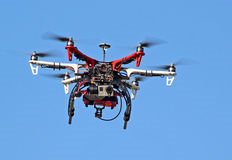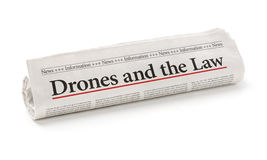By: Howard S. Goldman, Esq.
I. Introduction
 Drones are no longer the military robots or science fiction creations that we once imagined them to be. In fact, in 2016, according to the Consumer Technology Association, an estimated 3 million drones were purchased for use by hobbyists and businesses alike. Non-military drones are generally used either commercially or by hobbyists. All drone usage is regulated by the Federal Aviation Administration, or FAA, but hobbyists are only required to obtain a $5 registration, and can be as young as 13 years old. Businesses operating small drones are regulated by stricter standards.
Drones are no longer the military robots or science fiction creations that we once imagined them to be. In fact, in 2016, according to the Consumer Technology Association, an estimated 3 million drones were purchased for use by hobbyists and businesses alike. Non-military drones are generally used either commercially or by hobbyists. All drone usage is regulated by the Federal Aviation Administration, or FAA, but hobbyists are only required to obtain a $5 registration, and can be as young as 13 years old. Businesses operating small drones are regulated by stricter standards.
II. Drones and the Law: An Overview
The FAA’s rules regulating drone usage are known as “part 107”. Under part 107, all drones must be registered if they weigh between .55 and 55 lbs. Drones over 55 lbs. must be registered through the FAA’s Aircraft Registry.
In Massachusetts, commercial drone operators must be 17 years old, be certified to fly a drone by the FAA, stay out of airport space and other controlled airspace, operate during daylight hours only, fly no more than 400 feet above the ground at no more than 100 miles per hour, and not fly over any person not directly involved in flying the drone.
Several federal bills have been proposed to help regulate drone usage. These have all been within the privacy rights and expectations of privacy guaranteed under the Fourth Amendment, and would create a much stricter standard for everyday drone usage.
III. How Drones Can Benefit Condos
A growing number of homeowners associations and condos have begun using drones to inspect common areas, architectural improvements, opens spaces on property, and rooftop or higher up balcony areas. Many are even planning on using drones for deliveries.
The most obvious advantage of drone usage is cost its effectiveness. Having a drone do the work that would usually be done by a property manager or delivery person could potentially, radically cut condo costs. However, the potential benefits of drone usage must be balanced with the risk that drones can also pose.
IV. Turbulent Air: What Risks Drones Can Pose to Condos
 Drones are not without risk, and combined with a general distaste that many have for drones, drone usage may not be ideal for many condos. Some of these potential risks include infringing on privacy rights of unit owners and tenants, especially if a drone can “see” directly into someone’s unit. This would especially be an issue if the drone was being used for rooftop or balcony inspections.
Drones are not without risk, and combined with a general distaste that many have for drones, drone usage may not be ideal for many condos. Some of these potential risks include infringing on privacy rights of unit owners and tenants, especially if a drone can “see” directly into someone’s unit. This would especially be an issue if the drone was being used for rooftop or balcony inspections.
Other risks include a drone accident that could cause damage to property, as well as to people. Many people also seem to share a dislike for drones, citing “big brother” concerns.
Noise from drones could also potentially create nuisance issues. A property owner could feasibly assert a nuisance claim if, for example, the loud noise from a drone being used on a consistent basis interferes with that person’s quiet enjoyment of his or her property.
V. Potential Criminal Drone Charges
Other than nuisance violations, there are potentially more serious, criminal risks that could come with drone usage. These can include criminal trespassing, if the drone is flown onto private property, and assault with a dangerous weapon, if the drone operator attacks or threatens a person with a drone.
More likely offenses pertaining to condos and drone usage include stalking, if drones are used to record or “watch” someone, and malicious property damage if an errant drone was to smash into someone’s balcony or unit.
VI. Taking Action: What Forward-Thinking Condo Leaders Should Do
A good way of determining whether and how drones can be used in your condo is to first test the temperature of unit owners by having a joint, open meeting with unit owners and condo leaders.
Once the climate has been assessed, condo leaders can then come together and proactively decide on various issues pertaining to drone usage. Practical issues to consider can include creating a designated, common area landing site where delivery drones can operate, with strict drone delivery hours. For inspection drones, for example, there should be clear notifications about the time and date of planned inspections, the purpose of the inspections, and clear measures to be taken that will protect the privacy rights of unit owners and tenants.
Any and all regulations should then be adopted in the Condominium Rules and Regulations, with all unit owners being clearly notified, in writing, about these amendments.
VII. Conclusion
In all likelihood, drones will become increasingly ubiquitous. Condos that deal proactively with the complex balancing of drone usage will clearly benefit. Every condo will have a different set of issues to take into consideration when deciding if and how they should use drones. Either way, these decisions should be reflected in the Rules and Regulations of the Condominium.
About the Authors
Attorney Howard S. Goldman is the founding partner of the law firm of Goldman & Pease LLC, 160 Gould Street, Needham, Massachusetts 02494 (781) 292-1080. Mr. Goldman concentrates his practice in the areas of real estate, finance, and civil litigation, where he represents property managers, lending institutions, developers, and contractors for more than thirty years. He is an active member of the Massachusetts, Norfolk, and Rhode Island Bar Associations in his field and is also an active member of CAI and IREM, where he frequently lectures and writes columns affecting the real estate and finance industries. Mr. Goldman serves as a member of the Zoning Board of Appeals for the Town of Needham and as a court appointed mediator at the Boston Municipal Court and as a pro bono advocate at Federal District Court mediations.
Attorney Laura M. Moisin, a litigation associate at the law firm of Goldman & Pease LLC, provided much assistance in preparing this article.

